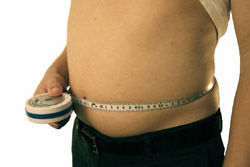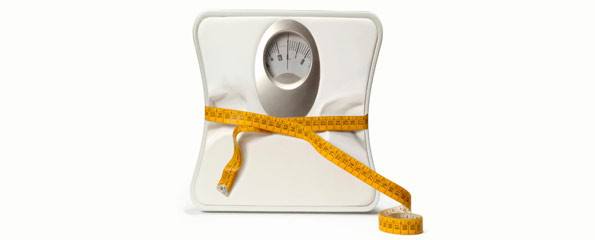Assessing Central Obesity: Waist Circumference
 Introduction to waist circumference
Introduction to waist circumference- Central obesity/abdominal fat mass
- How does waist circumference compare to other obesity measurements?
- Measuring waist circumference
- Waist circumference cut-off levels
- Waist circumference cut-off levels
- Importance of reliable and accurate measurement of waist circumference
- Combining anthropometrical measures to predict obesity-related risk
- Limitations of waist circumference
Introduction to waist circumference
Measuring a person’s waist circumference (WC) is the simplest way to assess central obesity. WC has been shown to be one of the most accurate anthropometrical indicators of abdominal fat. It is closely correlated to the waist to hip ratio (WHR), but is thought to be a more reliable measure of abdominal fat; the WHR can mask the status of abdominal obesity with a disproportionately large hip circumference.
WC can also be used as a complimentary measurement tool to give additional information on body fat to people within the healthy weight range wanting to build muscle or improve their diet.
Central obesity/abdominal fat mass
Central obesity is an excess accumulation of fat in the abdominal area, particularly due to excess visceral fat. As visceral fat is supplied by the portal blood system, excess fat in this area can lead to the release of fatty deposits into the bloodstream. Fatty buildup in the blood is responsible for the majority of negative health consequences associated with obesity, such as:
- Type 2 diabetes;
- Glucose intolerance;
- High blood pressure;
- Endometrial cancer;
- Artherosclerosis;
- Insulin resistance;
- Altered metabolic profile;
- Metabolic syndrome;
- Cardiovascular disease;
- Obesity-related lipid disorders (e.g. hypertriglyceridaemia; hypo-HDL-cholesterolaemia).
Central obesity is very common in elderly people because body fat is often redistributed to the abdominal region during the ageing process. On average, premenopausal women have half the abdominal fat of men; this is largely due to body shape. While women generally have a higher total and percentage body fat, it is more often located on their hips and thighs due to their pear-shaped bodies. Men naturally have an apple shape, and carry excess weight in their abdominal region.
How does waist circumference compare to other obesity measurements?
The standard measurement of overweight and obesity is the body mass index (BMI). The BMI is calculated using body mass and height, and the resulting score is an indirect measure of body fat.
This information will be collected for educational purposes, however it will remain anonymous.
However, there is not always a direct and clear correlation between total body fat and risk for obesity-related conditions. This makes BMI alone insufficient for determining the risk of serious conditions. Excess abdominal fat, on the other hand, will predispose obesity-related disease regardless of overall body fat. This highlights the importance of measuring WC. BMI remains the best indication of underweight and WC should not be used for this measure.
It is important to note that two people with very similar BMIs may vary substantially in the proportion of abdominal fat. Accordingly, a person with a BMI in the “normal” weight range may exceed the safe range of abdominal fat. A prime example of this is in older people. As lean muscle mass declines, their BMI may not change, but fat levels may be increasing with the accompanying redistribution of body fat.
Measuring waist circumference
 Waist measurements should be taken as you breathe out. You should relax and not contract any abdominal muscles. Align the tape measure at the level of the belly button, and circle the whole way around the body and back to the starting point.
Waist measurements should be taken as you breathe out. You should relax and not contract any abdominal muscles. Align the tape measure at the level of the belly button, and circle the whole way around the body and back to the starting point.
Waist circumference cut-off levels
As a general guide, increased obesity-related health risks are associated with a WC greater or equal to 94 cm in men and 80 cm in women. If a man has a WC greater than 102 cm, he is at a substantially increased risk, as are females with a WC greater than 88 cm. A WC greater than 120 cm for men and 110 cm for women puts these individuals at extremely high danger for obesity-related health issues.
Naturally, different ethnicities have different body builds and proportions. Therefore people of different ethnicities have different WC cut-off points. Asians have a naturally slimmer, petite frame and therefore the WC cut off for Japanese, Chinese and South Asian people is lower than for Caucasians. This means that if an Asian and Caucasian person of the same gender were both to have a WC of 94 cm, the Asian person would be at much greater risk of developing obesity-related disease.
Table 1: WC cut-off values for increased risk of metabolic syndrome and type 2 diabetes.
| Waist circmference (cm) | ||
|---|---|---|
| Ethnicity | Male | Female |
| European | 94 | 80 |
| South Asian | 90 | 80 |
| Chinese | 90 | 80 |
| Japanese | 90 | 80 |
| South & Central Americans* | 90 | 80 |
| Africans** | 94 | 80 |
| East Mediterranean & Middle Eastern** | 94 | 80 |
| * Appropriate data not yet available, so South Asian cut-off should be used. ** Appropriate data not yet available, so European cut-off should be used. | ||
Various obesity-related conditions that a high WC can predict include:
- Type 2 diabetes: WC is a stronger indicator of diabetes risk than BMI or WHR. See Table 1 for the WC cut-offs for increased diabetes risk.
- Cardiovascular disease (CVD): WC most strongly correlates with increased heart disease risk when WC > 102 cm for men and WC > 88 cm for women, but WC still shows moderate associations at 90 cm for men and 83 cm for women. Women with a WC as low as 72 cm have been shown to exhibit double the risk of heart disease than thinner females. Out of the measurements available, WC is the best indicator for CVD risk.
- High blood pressure: When WC exceeds 102 cm in males or 88 cm in females, they are at high risk of developing high blood pressure. This includes individuals with a BMI below the obese range, between 25.0 and 29.9. WHR is the best indicator of high blood pressure.
- Hernia: When WC is greater than 100 cm, individuals are at a higher risk of developing a hernia.
- Colorectal cancer: WC has been associated with an increased risk of developing colorectal cancer and colon cancer, especially in men.
Obesity-related risk factors that have been associated with WC, but as yet specific cut-off points have not been determined or can be better predicted using BMI or the WHR, include:
- Stroke: Stroke is better indicated by WHR.
- Heart attack: Specific cut-offs have not been determined for heart attack.
- Atherosclerosis: Both WC and WHR are strongly associated with risk of artherosclerosis, though specific cut-offs have not been determined.
 The WC measure is not usually used to identify risk in children and teenagers due to the lack of data to indicate appropriate cut-offs. Although further research is needed, there are some general recommendations:
The WC measure is not usually used to identify risk in children and teenagers due to the lack of data to indicate appropriate cut-offs. Although further research is needed, there are some general recommendations:
- A child with non-alcoholic fatty liver disease (NAFLD) along with a WC in or above the 90th percentile for their age has a high risk of developing liver fibrosis. Your doctor will be able to determine whether the child is at risk by comparing their WC and weight to the average for their age. If in the high risk group, the child should undergo a thorough liver investigation, including a biopsy.
- Cardiovascular disease risk increases in 12–19 year olds with a WC between 66.8–87.5 cm and above for boys, and 71.5–87.2 cm and above for girls. The ranges are so large due to ethnicity and age differences.
A high WC in children and adolescents is also associated with:
- Higher blood pressure;
- Lower HDL (‘good’) cholesterol;
- Increased thickness of left ventricular wall in the heart;
- Higher blood cholesterol; and
- Higher triglyceride levels.
Importance of reliable and accurate measurement of waist circumference
Make sure you are measuring yourself correctly. If a simple measurement error leads to an underestimation of your WC, you may incorrectly think that you are not at risk for a number of conditions and diseases; conversely, an overestimation may cause you unneeded anxiety. You should see your doctor for an evaluation if you think you carry excess weight in your abdominal region.
Combining anthropometrical measures to predict obesity-related risk
Even though WC has been reported to be a better indicator of obesity-related risk than BMI or WHR, it is still vital that all three measures are assessed. Each has its own strengths and weaknesses, and each will identify different aspects of obesity. Furthermore, emerging research has identified specific combinations of results that have certain risks. For example, a person with a high WC and a lower BMI has a greater risk of death after a heart attack than somebody with a high WC and a high BMI. This is thought to be due to a lower muscle mass and a lack of functional subcutaneous adipose tissue in the lower BMI sample.
Limitations of waist circumference
The major limitation of the WC measure is the great inter-ethnic variability that exists. This is especially relevant in multicultural countries such as Australia. It is recommended that, regardless of country of residence, different ethnicities are assessed using the appropriate cut-off.
More information
 | For more information on nutrition, including information on types and composition of food, nutrition and people, conditions related to nutrition, and diets and recipes, as well as some useful videos and tools, see Nutrition. |
 | For more information on obesity, health and social issues, and methods of weight loss, as well as some useful tools, see Weight Loss. |
References
- Lee K, Song YM, Sung J. Which obesity indicators are better predictors of metabolic risk?: Healthy Twin Study. Obesity (Silver Spring). 2008;16(4):834-40. [Abstract | Full text]
- McArdle WD, Katch FI, Katch VL. Exercise Physiology: Energy, Nutrition, and Human Performance (5th edition). Baltimore: Lippincott Williams & Wilkins; 2001. [Book]
- Wahlqvist ML. Australia and New Zealand: Food and Nutrition (2nd edition). Crows Nest: Allen and Unwin; 2002. [Book]
- Feldstein CA, Akopian M, Olivieri AO, et al. A comparison of body mass index and waist-to-hip ratio as indicators of hypertension risk in an urban Argentine population: A hospital-based study. Nutr Metab Cardiovasc Dis. 2005:15(4):310-5. [Abstract]
- Wu CH, Heshka S, Wang J, et al. Truncal fat in relation to total body fat: Influences of age, sex, ethnicity and fatness. Int J Obes (Lond). 2007;31(9):1384-91. [Abstract | Full text]
- Tovée MJ, Benson PJ, Emery JL, et al. Measurement of body size and shape perception in eating-disordered and control observers using body-shape software. Br J Psychol. 2003;94(Pt 4):501-16. [Abstract]
- Suk SH, Sacco RL, Boden-Albala B, et al. Abdominal obesity and risk of ischemic stroke: The Northern Manhattan Stroke Study. Stroke. 2003;34(7):1586-92. [Abstract | Full text]
- Diaz VA, Mainous AG 3rd, Baker R, et al. How does ethnicity affect the association between obesity and diabetes? Diabet Med. 2007;24(11):1199-204. [Abstract]
- Wang Y, Jacobs EJ, Patel AV, et al. A prospective study of waist circumference and body mass index in relation to colorectal cancer incidence. Cancer Causes Control. 2008;19(7):783-92. [Abstract]
- Kadowaki T, Sekikawa A, Murata K, et al. Japanese men have larger areas of visceral adipose tissue than Caucasian men in the same levels of waist circumference in a population-based study. Int J Obes (Lond). 2006;30(7):1163-5. [Abstract | Full text]
- Valsamakis G, Chetty R, Anwar A, et al. Association of simple anthropometric measures of obesity with visceral fat and the metabolic syndrome in male Caucasian and Indo-Asian subjects. Diabet Med. 2004;21(12):1339-45. [Abstract]
- The IDF consensus worldwide definition of the metabolic syndrome [online]. Brussels, Belgium: International Diabetes Federation. 8 March 2007 [cited 5 April 2009]. Available from: URL link
- Panoulas VF, Ahmad N, Fazal AA, et al. The inter-operator variability in measuring waist circumference and its potential impact on the diagnosis of the metabolic syndrome. Postgrad Med J. 2008;84(993):344-7. [Abstract]
- Balkau B, Deanfield JE, Després JP, et al. International Day for the Evaluation of Abdominal Obesity (IDEA): A study of waist circumference, cardiovascular disease, and diabetes mellitus in 168,000 primary care patients in 63 countries. Circulation. 2007;116(17):1942-51. [Abstract | Full text]
- De Raet J, Delvaux G, Haentjens P, Van Nieuwenhove Y. Waist circumference is an independent risk factor for the development of parastomal hernia after permanent colostomy. Dis Colon Rectum. 2008;51(12):1806-9. [Abstract]
- Winter Y, Rohrmann S, Linseisen J, et al. Contribution of obesity and abdominal fat mass to risk of stroke and transient ischemic attacks. Stroke. 2008;39(12):3145-51. [Abstract | Full text]
- Zeller M, Steg PG, Ravisy J, et al. Relation between body mass index, waist circumference, and death after acute myocardial infarction. Circulation. 2008;118(5):482-90. [Abstract | Full text]
- Lear SA, Humphries KH, Kohli S, et al. Visceral adipose tissue, a potential risk factor for carotid atherosclerosis: Results of the Multicultural Community Health Assessment Trial (M-CHAT). Stroke. 2007;38(9):2422-9. [Abstract | Full text]
- Messiah SE, Arheart KL, Lipshultz SE, Miller TL. Body mass index, waist circumference, and cardiovascular risk factors in adolescents. J Pediatr. 2008;153(6):845-50. [Abstract]
- Manco M, Bedogni G, Marcellini M, et al. Waist circumference correlates with liver fibrosis in children with non-alcoholic steatohepatitis. Gut. 2008;57(9):1283-7. [Abstract]
Dates
Tags
Created by:

 Login
Login














